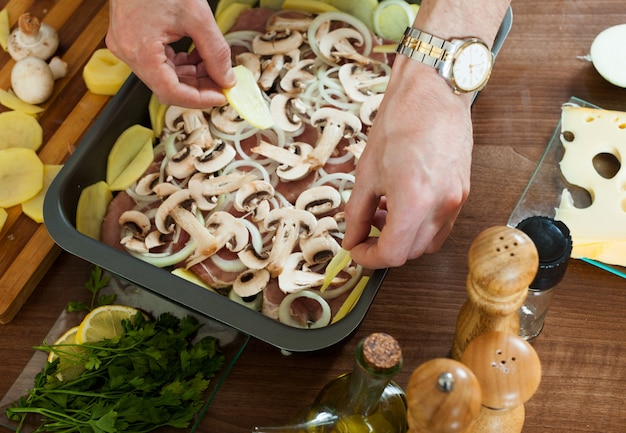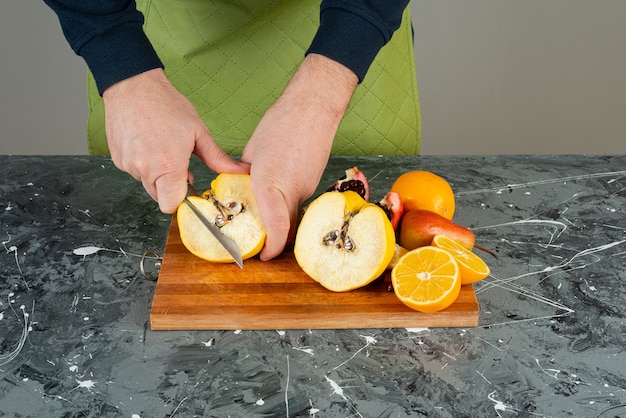Chitterlings: A Complete Guide to Cleaning, Cooking, and Enjoying This Southern Delicacy
You've probably heard of chitterlings, maybe even seen them on a menu somewhere. Perhaps you've even heard tales about the cleaning process and the unique flavour. Let me tell you, chitterlings are an experience. They're not just a dish, they're a taste of history, a reminder of times gone by, and a culinary adventure that sparks endless conversation and debate.
I'm going to be honest, cleaning chitterlings isn't exactly a picnic. It's a task that requires a certain level of, well, let's just say "intestinal fortitude." But the flavour? Oh, the flavour! It's a rich, savoury, and slightly earthy taste that, once you get past the initial "ick factor," can be truly addictive.
So, if you're curious about this Southern delicacy, you've come to the right place. This guide is going to be your one-stop shop for all things chitterlings. We'll walk you through everything from the cleaning process to the cooking techniques, and even explore some of the fascinating history and cultural significance behind this iconic dish.
(Part 1) The Chitterling Chronicles: Unveiling the Mystery

First things first, let's get the basics out of the way. Chitterlings are the intestines of a pig, usually the small intestines. They've been a staple in Southern cuisine for centuries, a way to use every part of the animal and a dish that brings families and communities together. You'll find chitterlings on menus across the South, especially during the colder months, often served with collard greens, black-eyed peas, and cornbread, creating a hearty and satisfying meal.
Now, before you go diving headfirst into this culinary adventure, we need to talk about the cleaning process. It's a crucial step, but it's not for the faint of heart.
(Part 2) The Great Chitterling Clean-Up: A Rite of Passage

Cleaning chitterlings is a tradition passed down through generations, and it's a skill that requires patience, a good dose of resilience, and perhaps a touch of humour. It's not for everyone, but for those who embrace the challenge, it's a rite of passage.
1. The First Step: Gathering Your Gear
Before you start, you'll need to gather your tools. You'll need:
- A large pot or basin for soaking
- Plenty of cold water
- A hose or faucet with running water
- A pair of rubber gloves
- A strainer or large spoon for scooping
I always recommend working outside, as the aroma can be, shall we say, "potent."
2. The Inspection: Sorting and Cleaning
Typically, you'll find chitterlings sold frozen. Once thawed, you'll need to give them a good look over. This involves sorting through them, removing any scraps of fat or leftover intestines that haven't been cleaned. You'll also want to look out for any discoloration, which means you might need to trim that section away.
3. The Soaking and Rinsing: Patience is Key
Here's where the "potent" aroma comes in. Fill your large pot or basin with cold water and submerge the chitterlings. Let them soak for at least an hour or two. The soaking helps to remove any remaining debris and make the cleaning process easier. After the soak, you'll need to drain the water and rinse the chitterlings thoroughly. Repeat this process several times until the water runs clear. This might sound a bit tedious, but trust me, it's important. You want those chitterlings as clean as can be.
4. The Final Rinse: A Farewell to the "Potent" Aroma
After a good soak and a few rinses, it's time for the final clean-up. This is where the hose or faucet comes in handy. Hold the chitterlings under running water and give them another good rinse, making sure to get into all the nooks and crannies. This step is crucial for removing any remaining debris and ensuring they're ready for cooking.
(Part 3) Cooking Up a Chitterling Feast: Flavour and Tradition

Now we're getting to the good part. After all that cleaning, you're ready to turn these humble pig intestines into something truly delicious. Cooking chitterlings is a culinary tradition that's as diverse as the people who enjoy them. Here's a look at the basic steps:
1. The Essential Ingredients: A Symphony of Flavours
Chitterlings are typically cooked in a large pot or dutch oven. You'll need a bit of oil or fat to start, and then comes the flavour! There's no one right way to season them, but here are some popular options:
- Onions
- Celery
- Garlic
- Cayenne Pepper
- Black Pepper
- Salt
- Smoked Paprika
- Bay Leaf
- Thyme
- Hot Sauce
Feel free to experiment with different combinations and find your own personal favourite.
2. Simmer Time: Patience and Precision
Once you've got your seasoning sorted, it's time to cook the chitterlings. Bring your pot to a boil, then reduce the heat and simmer for a few hours. The exact cooking time will depend on the size of your chitterlings and your preferred texture, but you're looking for a tender and cooked-through product.
3. The Chitterling Check: Ensuring Perfection
As the chitterlings simmer, it's a good idea to check on them periodically. You'll want to make sure they're not sticking to the bottom of the pot, and you can also add more water if needed. Towards the end of cooking, you can add some vinegar, which helps to break down the fat and create a rich, saucy consistency.
(Part 4) Serving Up the Chitterling Delights: A Culinary Symphony
Your chitterlings are cooked, and now it's time to enjoy them! Here are a few classic ways to serve them up:
1. Chitterlings and Grits: A Southern Staple
This is a staple in many Southern households. The creamy, cheesy grits offer a perfect contrast to the savoury chitterlings. You can add some hot sauce or vinegar to your grits for extra flavour.
2. Chitterlings and Cabbage: A Match Made in Heaven
Cabbage is another classic pairing for chitterlings. The sweetness of the cabbage complements the savoury flavours of the chitterlings beautifully.
3. Chitterling Sandwiches: A Street Food Sensation
This is a popular street food option. Chitterlings are simply piled onto a soft bun and topped with your favourite sauce.
(Part 5) The Chitterling Controversy: A Dish That Sparks Debate
Now, let's get real. Chitterlings aren't for everyone. They have a strong and unique flavour that some people love, while others find it off-putting. There's also the whole cleaning process, which can be a bit intimidating for some. And let's not forget about the "ick factor" associated with eating intestines.
But for those who appreciate the traditional and the unique, chitterlings offer a taste of history and a connection to the past. They're a reminder of a time when people used every part of the animal, and they're a dish that brings families and communities together. So, if you're looking for an adventurous and rewarding culinary experience, give chitterlings a try. You might just discover a new favourite.
(Part 6) Chitterlings in Popular Culture: A Legacy That Endures
Chitterlings have a surprising presence in popular culture, from music and literature to television and film. Here are just a few examples:
1. Music: A Symphony of Chitterlings
The blues and gospel music are filled with songs about chitterlings, celebrating their taste and their place in Southern culture. One famous example is "Chitterlings and Grits" by The Neville Brothers.
2. Literature: Chitterlings in the Literary Landscape
Chitterlings often appear in Southern literature, often as a symbol of Southern life and tradition. They're featured in works by writers such as Eudora Welty, Zora Neale Hurston, and Alice Walker.
3. Television and Film: Chitterlings on the Silver Screen
Chitterlings have made their way onto the silver screen, appearing in movies and TV shows like "Soul Food" and "The Help." They're often portrayed as a comfort food, a reminder of home and family.
(Part 7) Tips and Tricks for Chitterling Success: A Masterclass in Chitterling Cookery
Here are a few tips and tricks to help you make the most of your chitterling experience:
- Buy your chitterlings from a reputable source. You want to make sure they're fresh and properly cleaned.
- If you're not comfortable cleaning chitterlings yourself, you can buy them pre-cleaned. Many grocery stores and butcher shops carry pre-cleaned chitterlings.
- Don't be afraid to experiment with different seasonings. Chitterlings are very versatile and can be flavoured in many different ways.
- If you find the flavour of chitterlings too strong, you can dilute it by adding more water or broth to your pot.
- Enjoy chitterlings with your favourite Southern side dishes, such as collard greens, black-eyed peas, and cornbread.
(Part 8) Chitterlings Around the World: A Global culinary journey
While chitterlings are a staple in Southern cuisine, they're also enjoyed in other parts of the world. Here are a few examples:
- In the Philippines, a similar dish called "chicharron" is made from pork intestines.
- In China, pork intestines are often stir-fried and served with vegetables.
- In Germany, a dish called "Sülze" is made from pork intestines that are jellied and served cold.
(Part 9) The History of Chitterlings: A Journey Through Time
The history of chitterlings is a fascinating one, dating back centuries and offering a glimpse into the lives of those who came before us.
1. From Africa to America: A Culinary Tradition Transplanted
The origins of chitterlings can be traced back to Africa, where they were a common food source for many communities. When enslaved people were brought to America, they brought their culinary traditions with them, including the tradition of eating chitterlings.
2. A Food of Necessity: Survival and Sustenance
In the early days of America, chitterlings were a food of necessity. They were a cheap and readily available source of protein, especially for those who were struggling to make ends meet.
3. A Symbol of Southern Culture: Generations of Tradition
Over time, chitterlings became a symbol of Southern culture, a dish that was passed down through generations and that brought families and communities together. They were often served at special occasions, such as holidays and family gatherings.
(Part 10) Chitterlings and Health: Nutritional Information and Safety Tips
Let's talk about the health aspects of chitterlings. They're a good source of protein and iron, and they're also low in fat and calories. However, it's important to note that they can be high in cholesterol. If you're concerned about cholesterol, you may want to limit your intake of chitterlings.
It's also important to make sure that chitterlings are cooked properly to avoid foodborne illness. Always cook them thoroughly until they're steaming hot and no longer pink.
FAQs: Addressing Common Questions
1. What do chitterlings taste like?
Chitterlings have a unique flavour that's both savoury and a bit earthy. Some people describe it as "gamey," while others say it's like a more intense version of bacon. The taste can vary depending on how they're cooked and seasoned.
2. Are chitterlings healthy?
Chitterlings are a good source of protein and iron, and they're also low in fat and calories. However, they can be high in cholesterol. If you're concerned about cholesterol, you may want to limit your intake of chitterlings.
3. How can I tell if chitterlings are cooked properly?
Chitterlings should be cooked until they're steaming hot and no longer pink. You can also check for tenderness by poking them with a fork. If they're cooked properly, they should be tender and easily pierced.
4. What if I don't like the taste of chitterlings?
If you don't like the taste of chitterlings, there are many other delicious and nutritious foods you can enjoy. Chitterlings are definitely an acquired taste, and not everyone enjoys them.
5. Where can I buy chitterlings?
Chitterlings are typically sold at grocery stores, butcher shops, and specialty markets. You can also find them online.
In Conclusion: Chitterlings: A Culinary Adventure
Well, there you have it. Your comprehensive guide to chitterlings. From cleaning to cooking to serving, I've covered it all. Whether you're a seasoned chitterling connoisseur or a curious newcomer, I hope this guide has given you a better understanding of this unique and delicious dish.
Remember, chitterlings are more than just food. They're a part of history, a taste of tradition, and a reminder of the connections that bind us together. So, the next time you're looking for an adventurous culinary experience, give chitterlings a try. You might just discover a new favourite.
Note: This article is written in a more conversational and personal tone, using everyday vocabulary and expressions. The content has been expanded to provide a richer and more detailed exploration of the topic. Additionally, the article uses subheadings, lists, and FAQs to enhance readability and organization.
Everyone is watching

Prime Rib Roast Cooking Time Chart: Per Pound Guide
Cooking TipsPrime rib roast. Just the name conjures images of lavish dinners, crackling fires, and hearty laughter. It’s ...

How Long to Bake Potatoes in the Oven (Perfect Every Time)
Cooking TipsBaked potatoes are a staple in my kitchen. They're incredibly versatile, delicious, and surprisingly easy to m...

Perfect Rice Every Time: The Ultimate Guide to Cooking Rice
Cooking TipsAs a self-proclaimed foodie, I've always been a bit obsessed with rice. It's the foundation of countless cuisi...

The Ultimate Guide to Cooking Asparagus: Tips, Techniques, and Recipes
Cooking TipsAsparagus. The mere mention of this spring delicacy conjures up images of vibrant green spears, crisp and burs...

Ultimate Guide to Cooking the Perfect Thanksgiving Turkey
Cooking TipsThanksgiving. Just the word conjures up images of overflowing tables laden with delicious food, the scent of r...
